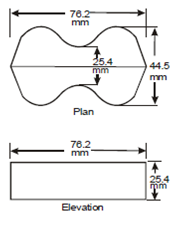Tensile Strength Test:
This test was formerly used to get an indirect indication of compressive strength of cement. Generally, it is used for rapid hardening cement. The procedure is given below.
(a) The mortar of cement and sand is prepared in the proportion of 1: 3.
(b) The quantity of water 8% by weight of cement and sand is added to the mortar.
(c) The briquette mould is filled with mortar and then a small heap of mortar is created at its top. It is beaten down through a standard spatula till water appears on the surface. Similar procedure is repeated for the other face of briquette. Twelve like standard briquettes are prepared.
(d) The briquettes are remaining in a damp cabin for 24 hours.

Figure: Briquette Mould
(e) The briquettes are carefully removed from the moulds and they are submerged in clean water for curing.
(f) The briquettes are tested within testing machine at the end of 3 days and 7 days. Six briquettes are tested in each test and average is found out. During the test, the load is to be applied uniformly at the rate of 35 kg/cm2.
(g) The cross-sectional area of briquette at its least section is 6.45 cm2. Hence the ultimate tensile stress of cement paste is obtained from the following relation.
(h) Ultimate tensile stress = Falling Load/6.45.
(i) The tensile stress on the end of 3 days should not be less than 20 kg/cm2 and that at the end of 7 days should not be less than 25 kg/cm2.